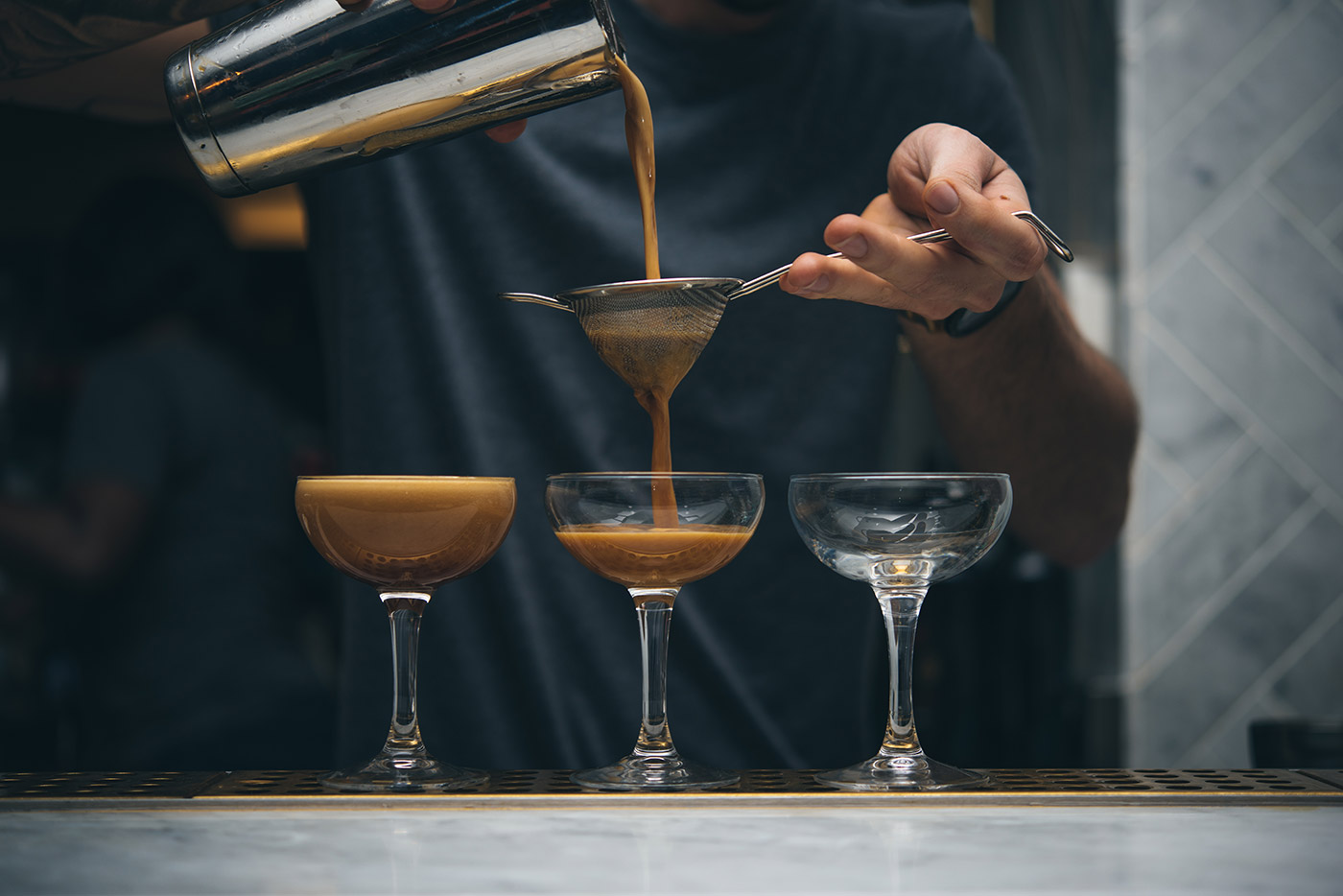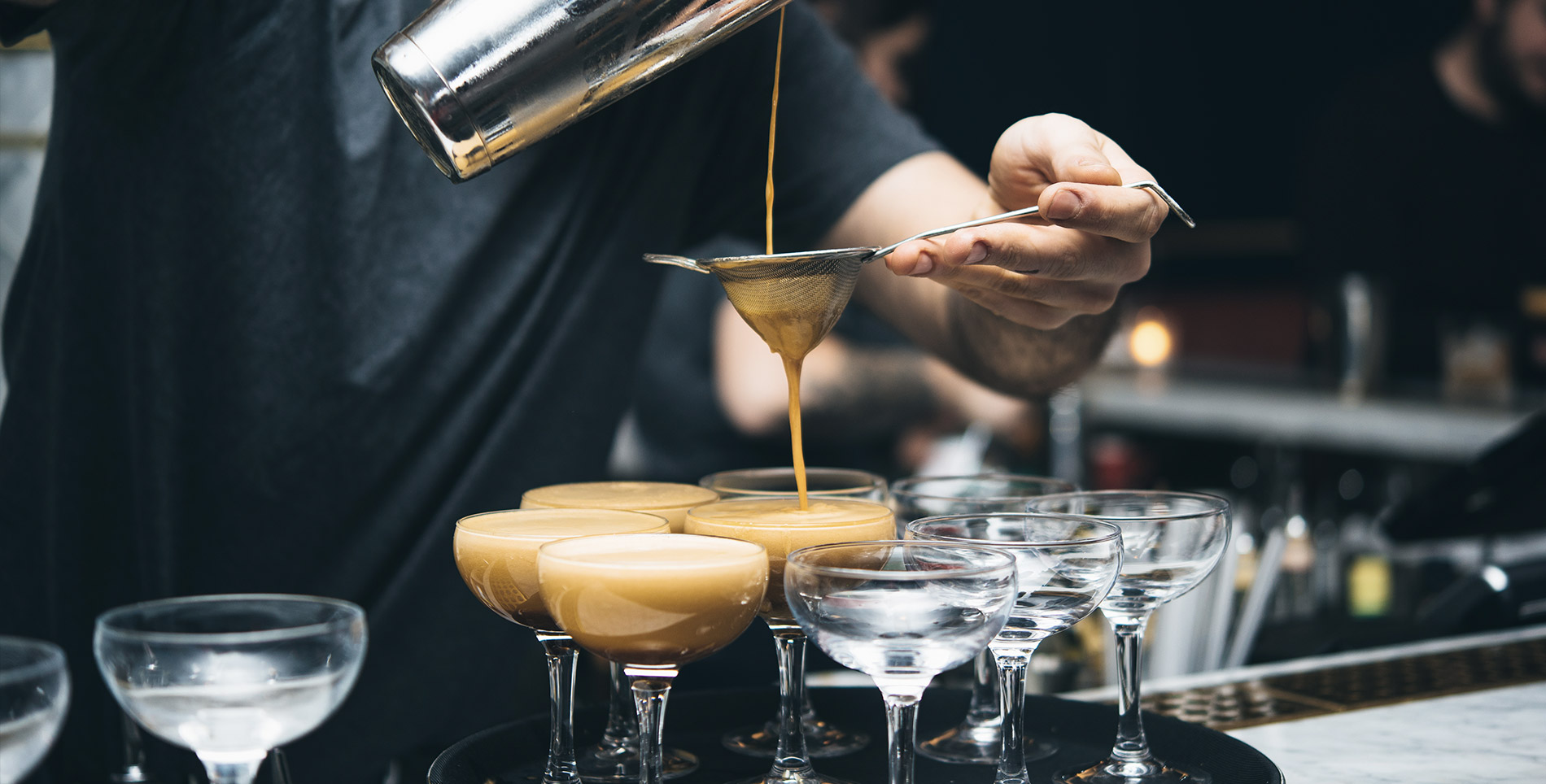From the ![]() Coffee Issue
Coffee Issue
“Underpinning the whole thing is the demand for a cocktail that gives you that buzz,” Grind & Co.’s Head of Coffee and Beverages, Sam Trevethyen, says. At Grind & Co., a family of fast-paced café-bar joints across London, the house-roasted espresso is the driving force behind their all-day menus, from the first brew poured right through to evening service. Trevethyen explains that while the espresso martini has experienced a revival in both the U.K. and the U.S., coffee-based cocktails are now having their own moment too.
“We’ve seen the espresso martini explode in the U.K. over the last five to six years, and in the States in the last one or two years,” he says. It’s no coincidence that boom has come about, following the burgeoning of third wave coffee. “Nowadays, that access to good coffee is here and people are very understanding of it; it’s a smooth segue jumping from quality coffee to quality coffee cocktails.”
London is ground zero for the world’s most famous coffee cocktail. Bartender Dick Bradsell first served up the espresso martini in 1983 at Soho Brasserie answering the legendary request, “wake me up, then fuck me up” from the mystery model who ordered it.
“In an espresso martini, the difference between using instant coffee and fresh espresso made on a commercial espresso machine is massive,” says Trevethyen, noting in its early days the coffee being used in the cocktail was pretty forgettable. “With the growth of specialty coffee and the slow food movement, everything turned back to high-quality ingredients.”
Once considered a cringeworthy upper-meets-downer libation, sharing the same camp as the likes of the Vodka Red Bull, of late the espresso martini has been elevated by bartenders’ keen focus on starting off with a superior brew. Espresso martinis now grace the cocktail menus of New York spots like Koi, Primo’s and The Modern. At Grind & Co., it’s the very same bean blend used in their coffees that turns up in a number of their coffee-based cocktails. “When you start with a killer espresso, there’s no need to mess with it,” says Trevethyen. “Our house blend is rich, sweet, with loads of nut and chocolate [notes]. It’s coffee that really tastes like coffee, with lots of body, so it works really well in coffee cocktails.”
These days, it’s not an uncommon offering at your average British pub, sometimes even served on tap. Just a couple months ago, even Kahlúa launched a ready-to-drink canned version complete with a nitro-induced frothy finish. Australia has even had its own dedicated espresso martini festival for a few years running, sponsored by Mr. Black, an artisan cold brew coffee liqueur that started Down Under.
“The espresso martini is popular where good coffee is having a resurgence—think cities like London, Berlin, Amsterdam, New York and Los Angeles, which are leading the charge. Like the negroni or old fashioned, it’s certainly achieved modern classic status now,” says Tom Baker, founder of Mr. Black. His aim in launching the liqueur in 2013 was to create the chance to enjoy Australia’s lauded café culture right through to evening. Baker and team source direct-trade green beans from four different producers throughout the year, roasting the goods themselves before cold-extracting the coffee to create a rich, thick, low-acidity cold brew that’s then blended with a neutral wheat-based spirit. It’s a major departure from commercial brands’ sickly sweet, two-dimensional coffee-flavored elixirs.
As with the rise of the espresso martini, Baker notes the market for high-quality coffee liqueurs is likewise growing on the back of the specialty coffee movement. “When we started five years ago, there were no other craft coffee liqueurs. Now there are over fifty,” he says. “In both New York and London, we’re seeing … more novel takes on coffee cocktails. An espresso martini is a real coffee punch in the face. Bartenders now understand there’s a nuanced way to get coffee into drinks.”
Take the cocktail menus at Grind & Co.’s establishments. As well as a selection of espresso-based drinks, there’s the Chai Your Luck, made with filter coffee, dark rum, chai and oat milk. “You get this long, tall, fruity, tropical drink. The richness of the rum plays well with the acidity and fruitiness of the filter coffee,” says Trevethyen. Or the Dangerously Good, a “pet project” for Trevethyen that mixes filter coffee with Irish whiskey and Baileys cream. “It’s our twist on an Irish coffee, making it into something younger people might be into.”

Across the pond, celebrated New York City spots are embracing the same approach. Apotheke serves a beverage dubbed the Third Rail—a mix of brewed coffee, fresh ginger, lime juice, and dark rum. Broken Shaker makes the Cafecito Anticuado with bourbon, rye whiskey, orange bitters, and Mr. Black, while Dead Rabbit’s Reality Check combines scotch, cognac, honey, pineapple juice, lemon and coffee.
“Coffee is complex and far-reaching, rather than being just a fixed flavor point,” says Trevethyen. “We’re finally seeing coffee as an actual ingredient.” He notes that in cocktail creation, the type of gin or whiskey has long been a major consideration. “Now, it’s ‘what coffee am I going to use?’ too.”
Much like the birth of Mr. Black, the shared invention of a distiller and a coffee obsessive, Baker sees the future of coffee cocktails being taken forward by bartenders, rather than coffee professionals. “We’ve brought craft coffee into the night,” he says. “Bartenders are creating the next generation of complex, caffeinated cocktails. I’ve tried a lot of them, and I can promise you it’ll be delicious.”
Recipe
Grind & Co.’s Grind Espresso Martini
Ingredients:
- 1.4 oz (40 ml) vodka
- 1.2 oz (35 ml) espresso
- 0.7 oz (20 ml) white sugar syrup
Method:
In a cocktail shaker, build all the ingredients over ice and shake vigorously. Using a fine cocktail strainer, double strain into a chilled glass. Garnish with three coffee beans.







Our comments section is for members only.
Join today to gain exclusive access.